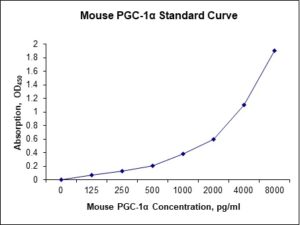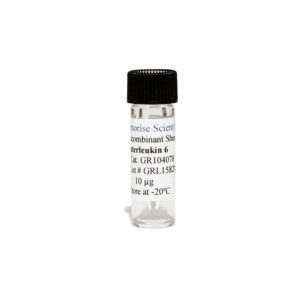Nori Mouse PGC-1a ELISA Kit
$508.00 – $916.00
This ELISA kit is for quantification of PGC-1a in mouse. This is a quick ELISA assay that reduces time to 50% compared to the conventional method, and the entire assay only takes 3 hours. This assay employs the quantitative sandwich enzyme immunoassay technique and uses biotin-streptavidin chemistry to improve the performance of the assays. An antibody specific for PGC1 has been pre-coated onto a microplate. Standards and samples are pipetted into the wells and any PGC1 present is bound by the immobilized antibody. After washing away any unbound substances, a detection antibody specific for PGC1 is added to the wells. Following wash to remove any unbound antibody reagent, a detection reagent is added. After intensive wash a substrate solution is added to the wells and color develops in proportion to the amount of PGC1 bound in the initial step. The color development is stopped, and the intensity of the color is measured.
Alternative names for PGC-1a: PPARG coactivator 1 alpha (PGC-1a), PPARGC1A, PGC1, PGC1a, PPARGC1
This product is for Laboratory Research Use Only not for diagnostic and therapeutic purposes or any other purposes.
- Description
- How Elisa Works
- Product Citation (0)
- Reviews (0)
Description
Nori Mouse PGC-1a ELISA Kit Summary
Alternative names for PGC-1a: PPARG coactivator 1 alpha (PGC-1a), PPARGC1A, PGC1, PGC1a, PPARGC1
| Assay Type | Solid Phase Sandwich ELISA |
| Format | 96-well Microplate or 96-Well Strip Microplate |
| Method of Detection | Colorimetric |
| Number of Targets Detected | 1 |
| Target Antigen Accession Number | O70343 |
| Assay Length | 3 hours |
| Quantitative/Semiquantitative | Quantitative |
| Sample Type | Plasma, Serum, Cell Culture, Urine, Cell/Tissue Lysates, Synovial Fluid, BAL, |
| Recommended Sample Dilution (Plasma/Serum) | No dilution for sample <ULOQ; sufficient dilution for samples >ULOQ |
| Sensitivity | 25 pg/mL |
| Detection Range | 125-8000 pg/mL |
| Specificity | Mouse PGC-1a |
| Cross-Reactivity | < 0.5% cross-reactivity observed with available related molecules, < 50% cross-species reactivity observed with species tested. |
| Interference | No significant interference observed with available related molecules |
| Storage/Stability | 4 ºC for up to 6 months |
| Usage | For Laboratory Research Use Only. Not for diagnostic or therapeutic use. |
| Additional Notes | The kit allows for use in multiple experiments. |
Standard Curve
Kit Components
1. Pre-coated 96-well Microplate
2. Biotinylated Detection Antibody
3. Streptavidin-HRP Conjugate
4. Lyophilized Standards
5. TMB One-Step Substrate
6. Stop Solution
7. 20 x PBS
8. Assay Buffer
Other Materials Required but not Provided:
1. Microplate Reader capable of measuring absorption at 450 nm
2. Log-log graph paper or computer and software for ELISA data analysis
3. Precision pipettes (1-1000 µl)
4. Multi-channel pipettes (300 µl)
5. Distilled or deionized water
Protocol Outline
1. Prepare all reagents, samples and standards as instructed in the datasheet.
2. Add 100 µl of Standard or samples to each well and incubate 1 h at RT.
3. Add 100 µl of Working Detection Antibody to each well and incubate 1 h at RT.
4. Add 100 µl of Working Streptavidin-HRP to each well and incubate 20 min at RT.
5. Add 100 µl of Substrate to each well and incubate 5-30 min at RT.
6. Add 50 µl of Stop Solution to each well and read at 450 nm immediately.
Background:
PPARG coactivator 1 alpha (PGC-1a) is a protein that is encoded by the PPARGC1A gene.[1] PGC-1a is a transcriptional coactivator that regulates the genes involved in energy metabolism. PGC-1a interacts with PPARgamma, which permits the interaction of this protein with multiple transcription factors. PGC-1a can interact with, and regulate the activities of, cAMP response element binding protein (CREB) and nuclear respiratory factors (NRFs). It provides a direct link between external physiological stimuli and the regulation of mitochondrial biogenesis, and is a major factor that regulates muscle fiber type determination. PGC-1a may be also involved in controlling blood pressure, regulating cellular cholesterol homoeostasis, and the development of obesity. The master energy homeostasis regulator PGC-1alpha exhibits an mRNA nuclear export function.[2] PGC-1alpha promotes colorectal carcinoma metastasis through regulating ABCA1 transcription.[3] Epigenetic suppression of PGC1alpha (PPARGC1A) causes collateral sensitivity to HMGCR-inhibitors within BRAF-treatment resistant melanomas.[4] Knockdown of PGC1alpha suppresses dysplastic oral keratinocytes proliferation through reprogramming energy metabolism.[5]
References
1. Esterbauer H, et al.(1999) Genomics 62 (1), 98-102
2. Mihaylov SR, et al. (2023) Nat Commun 14 (1), 5496
3. Chen W, et al. (2023) Oncogene 42 (32), 2456-2470
4. Liang J, et al. (2023) Nat Commun 14 (1), 3251
- Liu Y, et al. (2023) Int J Oral Sci 15 (1), 37
Be the first to review “Nori Mouse PGC-1a ELISA Kit”
You must be logged in to post a review.





























Reviews
There are no reviews yet.